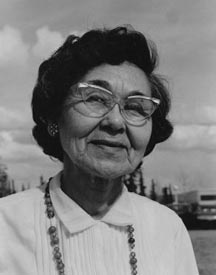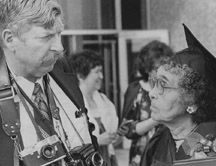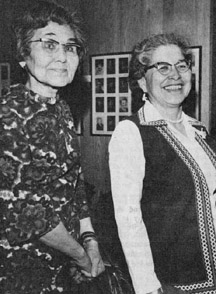Forward of "Tales of Ticasuk" - Part 1

Notes on the Author
Of all the legends collected over the years by Ticasuk, none are more interesting
than the true story of the incredible journey through life of Emily Ivanoff Brown.
It all began February 21, 1904, in Unalakleet where she was born to Amelia (Malquay)
and Stephan Ivanoff. He was a Russian-American-Eskimo boat builder, skilled carpenter,
storekeeper, and Covenant church missionary.
Emily's Eskimo name, Ticasuk, means "a hollow place in the ground" where the four
winds store the treasure they gather from all parts of the world; and Emily spent
her lifetime serving as a focal point where people and ideas could find a place to
get together.
Emily's parents built a roadhouse at Unalakleet, "well patronized by the mail carriers who travelled the North in winter by dog sled," she wrote in her book Roots of Ticasuk, published in 1981 by Alaska Northwest Publishing Company. Unfortunately, the prosperity they earned through their hard work was not appreciated in the village. "The chief said that they had broken the community taboo that 'no member of our village will rise in wealth over and beyond the others'," Emily was told.

The Ivanoffs sold their business "to white man" and moved with their three sons and
3-year-old Emily to Shaktoolik, farther along the shore of Norton Sound. It was here
at Shaktoolik that Emily began her education in a tent, beginning in the spring of
1909 at the age of 5.
She grew up on the cutting edge of two civilizations. Her mother clung to the old
ways of the Eskimo heritage, while Stephan held to the culture of the white man's
ways.
When she was about 15, she was sent to Chemawa Indian School in Salem, Oregon, where
she remained for 9 years. She was there so long that the other students often called
her "Grandma," but in the process of learning she received her elementary, high school,
and teaching certificate, enabling her to return to Alaska as a teacher in the school
at Kotzebue.
Although she enjoyed teaching, Ticasuk was appalled at the health hazards in the village
and she decided to become a nurse. She went back to the Pacific Northwest to study
nursing in Seattle.

Her nursing career was cut short when she met and married Robert Brown and the couple
returned to Alaska where they had three children. Emily's new vocation as a mother
was interrupted when her husband died, and she had to return to teaching to support
herself and her three sons.
In 1954, at the age of 50, Emily began 10 years of attending summer school at the
university to earn her bachelor of science degree in education while teaching full
time during the academic years.
By May 22, 1964, when she received her degree, one would think that Ticasuk would
have had enough education, but she immediately plowed into another course to study
the visually handicapped child.
She continued taking courses every summer even after she retired from 30 years of
teaching. Still, she studied on, after her three sons were grown and making their
own living.
Emily's thirst for knowledge was so great that in the fall of 1969 she moved onto
the campus at the University of Alaska in Fairbanks and stayed there through each
academic year until her death on May 3, 1982.
During her last semester, she was enrolled in an individual study course in Eskimo
heritage, but ill health was catching up with her and she spent very few days in her
room at 104 Wickersham Hall. Most of her spring semester in Fairbanks she spent at
Fairbanks Memorial Hospital, except for two trips home to Unalakleet.
In late March 1982, she flew to Anchorage to attend the Alaskan of the Year dinner
where she was to receive the governor's award for outstanding service to her fellow
Alaskans. Unfortunately, she was too tired to go to the dinner and her granddaughter
Paula, accepted the award for her.
Emily's service to her state was widely known and she received many awards throughout
her lifetime, including a presidential citation by Richard Nixon for her "exceptional
service to others, in the finest American tradition."
She was twice cited by the Alaska legislature for preservation of Alaska Native culture.
This included her involvement in the production of a dictionary for her own Malimiut
dialect of the Inupiaq Eskimo language. She was also assisting in the development
of a curriculum guide for teaching the Inupiaq language and culture in the elementary
schools.
Her teaching career included schools at Kotzebue, Unalakleet, Shaktoolik and Meade
River. After returning from teaching she was widely sought as a speaker or resource
person for conferences throughout the state.
At the same time, she continued her schooling, learning more about Native languages,
arts and culture, and concentrated on writing these things down for her own people
and to communicate their heritage to other cultures.
